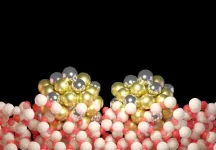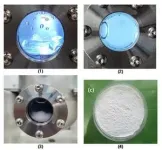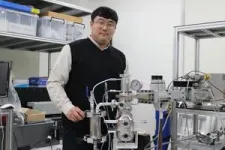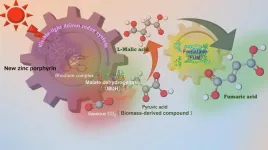(Press-News.org) Researchers from the Harvard John A. Paulson School of Engineering and Applied Sciences (SEAS), Harvard Department of Chemistry & Chemical Biology, and Utrecht University have reported on a previously elusive way to improve the selectivity of catalytic reactions, adding a new method of increasing the efficacy of catalysts for a potentially wide range of applications in various industries including pharmaceuticals, cosmetics and much more.
The research is published in Nature Catalysis.
The chemical industry relies on catalysts for over 90 percent of its processes and nearly all these catalysts consist of nanoparticles dispersed on top of a substrate. Researchers have long suspected that the size of individual nanoparticles and the distance between them play important roles in the speed of, and the products produced in the catalytic reaction, but because nanoparticles are prone to moving around and agglomerating during catalysis, it’s been difficult to study exactly how.
Over the past decade, Joanna Aizenberg, the Amy Smith Berylson Professor of Materials Science and Professor of Chemistry & Chemical Biology, and her lab have been drawing inspiration from nature to build highly ordered, porous materials for a wide range of catalytic reactions. Inspired by the structure of butterfly wings, the researchers designed a new catalyst platform that partially embeds nanoparticles into the substrate, trapping them so they don’t move around during catalysis, while leaving the rest of the nanoparticles’ surface exposed, enabling them to perform the catalytic reactions efficiently and without agglomeration.
The researchers found that the distance between particles had a huge impact on the selectivity of the reaction.
“Many industrially-relevant chemical reactions follow a cascade whereby chemical A is turned to chemical B which can then be turned into chemical C and so forth,” said Kang Rui Garrick Lim, a graduate student in the Aizenberg Lab and first author of the study. “In some catalytic processes, the intermediate chemical, chemical B, is the goal, while in others it is the end product, chemical C. The selectivity of the catalyst refers to whether it favors the production of chemical B or chemical C.”
A good example of this is the production of benzyl alcohol, a chemical used in everything from shellacks, paints, and leather production to intravenous medications, cosmetics, and topical drugs.
Benzyl alcohol is the intermediate chemical B, derived from the hydrogenation of benzaldehyde (chemical A), before the reaction creates toluene (chemical C), another commonly used chemical but of lower value. In order to produce benzyl alcohol efficiently, the formation of toluene needs to be suppressed.
Currently, to make the more useful benzyl alcohol, the catalytic hydrogenation reaction is slowed down, or not run to completion, to ensure that the reaction will stop at B and form as little toluene as possible.
“Generally, to make these intermediate chemicals, you make the catalyst less reactive and the overall reaction slower, which is not productive at all,” said Lim. “Catalysts are meant to speed things up, not slow them down.”
The researchers demonstrated their platform in the catalytic formation of benzyl alcohol. Lim and the team found that when catalytic metal nanoparticles were placed further apart on the substrate, the reaction was more selective towards benzyl alcohol, the intermediate chemical. When the nanoparticles were closer together, the reaction was more selective towards toluene, the end product. Given that the distance between nanoparticles can be adjusted synthetically using the bioinspired catalyst platform, the research suggests that the same catalyst platform can be easily adapted for a range of intermediate or end product chemicals.
“Catalysis is central to production of a whole range of extremely important materials that are used in pharmaceuticals, consumer products and in manufacturing many products all of us use in everyday life,” said Aizenberg. “Adding this selectivity-improving tool to the chemist’s arsenal is extremely important. It will allow more effective tuning of catalytic processes, more economical use of the feedstocks accompanied by the reduction of energy consumption and waste generation. We hope that chemists will use our platform in further optimization of new and existing catalytic processes.”
Next, the team will use the same platform to understand how the size of nanoparticles impacts the reaction at fixed distances between nanoparticles.
Harvard’s Office of Technology Development has protected the intellectual property out of Professor Aizenberg’s lab, which is the underlying technology of this research.
The research was co-authored by Selina K. Kaiser, Haichao Wu, Sadhya Garg,
Marta Perxes Perich, Jessi E. S. van der Hoeven and Michael Aizenberg. It was supported in part by the Integrated Mesoscale Architectures for Sustainable Catalysis (IMASC), an Energy Frontier Research Center funded by the US Department of Energy, Office of Science, Basic Energy Sciences under award number DE-SC0012573 and by the US Defense Threat Reduction Agency (DTRA) under award number HDTR1211001612.
END
Towards more efficient catalysts
Researchers expand ways to improve the selectivity of catalytic reactions
2024-02-16
ELSE PRESS RELEASES FROM THIS DATE:
Laboratory study on conditions for spontaneous excitation of "chorus emission," wave of space plasma
2024-02-16
A dipole magnetic field, created by a ring current, is the most fundamental type of magnetic field that is found both in laboratories and in space. Planetary magnetospheres, such as Jupiter's, effectively confine plasma. The RT-1 project aims to learn from nature and create a magnetosphere-type high-performance plasma to realize advanced fusion energy. Simultaneously, the artificial magnetosphere offers a means to experimentally understand the mechanisms of natural phenomena in a simplified and controlled ...
Advanced artificial photosynthesis catalyst uses CO2 more efficiently to create biodegradable plastics
2024-02-16
Amid growing global concern over climate change and plastic pollution, researchers at Osaka Metropolitan University are making great strides in the sustainable production of fumaric acid – a component of biodegradable plastics such as polybutylene succinate, which is commonly used for food packaging. The researchers have managed to efficiently produce fumaric acid, which is traditionally derived from petroleum, using renewable resources, carbon dioxide, and biomass-derived compounds.
In a previous study, a research team led by Professor Yutaka Amao of the Research Center for Artificial Photosynthesis at ...
Mystery solved: the oldest fossil reptile from the alps is an historical forgery
2024-02-16
A 280-million-year-old fossil that has baffled researchers for decades has been shown to be, in part, a forgery following new examination of the remnants.
The discovery has led the team led by Dr Valentina Rossi of University College Cork, Ireland (UCC) to urge caution in how the fossil is used in future research.
Tridentinosaurus antiquus was discovered in the Italian alps in 1931 and was thought to be an important specimen for understanding early reptile evolution.
Its body outline, appearing dark against the surrounding rock, was initially interpreted ...
The ties that bind
2024-02-15
Trace metals are nutrient elements, like zinc, that animals and plants need in small amounts to function properly. Animals generally get trace metals in their diets or through environmental exposures, while plants take their trace minerals up from soil. If we get too little, we may experience a deficiency, but the opposite can also be true: too much of a trace metal can be toxic.
Scientists believe that up to 50% of the trace metals in soils and urban environments may be bound to the surfaces of mineral grains — rendering the trace metals ...
New GSA publication addresses dementia care in adults with I/DD
2024-02-15
Addressing Brain Health in Adults With Intellectual Disabilities and Developmental Disabilities: A Companion to the KAER Toolkit for Primary Care Providers is a new publication from the Gerontological Society of America (GSA) designed to address the needs of adults with intellectual and developmental disabilities (I/DD) who develop dementia.
Freely available at geron.org/brainhealth, this companion document:
Raises awareness of unique needs of adults living with I/DD.
Equips and encourages caregivers and health care teams to engage in ...
Inequities in HIV testing, diagnosis and care for people with intellectual and developmental disabilities
2024-02-15
People with disabilities are often at higher risk for exposure to HIV due to barriers in engaging healthcare and other systemic factors and are thus considered a priority for prevention and testing efforts. However, these efforts don’t always extend to people with intellectual disabilities due to the perception that people with intellectual disabilities are mostly asexual.
Researchers at University of Michigan Health conducted one of the largest epidemiological studies of individuals with intellectual and developmental disabilities to closely examine where the gaps in HIV care lie and found large disparities in care for Black patients as well as for patients ...
Earthquake fatality measure offers new way to estimate impact on countries
2024-02-15
A new measure that compares earthquake-related fatalities to a country’s population size concludes that Ecuador, Lebanon, Haiti, Turkmenistan, Iran and Portugal have experienced the greatest impact from fatalities in the past five centuries.
The new impact measure, introduced in the Bulletin of the Seismological Society of America by Max Wyss and colleagues at International Centre for Earth Simulation Foundation, is called the earthquake fatality load or EQFL. The EQFL of a particular earthquake is the ratio of earthquake fatalities to the population estimate for the country in the year of the earthquake.
In their study, Wyss, Michel Speiser ...
Using cannabis can ease cravings for street-level drugs, UBC research suggests
2024-02-15
New findings from researchers at the University of British Columbia suggest that cannabis could play a role in addressing the ongoing opioid overdose crisis.
A new publication from Dr. Hudson Reddon, alongside UBC Okanagan’s Dr. Zach Walsh and UBC Vancouver’s Dr. M-J Milloy, observed that using cannabis is associated with decreased use of crystal methamphetamine among people at highest risk of overdose in Vancouver’s Downtown Eastside.
About 45 per cent of the study’s participants reported using cannabis to manage their cravings for stimulant drugs ...
New nuclei can help shape our understanding of fundamental science on Earth and in the cosmos
2024-02-15
EAST LANSING, Mich. – In creating five new isotopes, an international research team working at the Facility for Rare Isotope Beams, or FRIB, at Michigan State University has brought the stars closer to Earth.
The isotopes — known as thulium-182, thulium-183, ytterbium-186, ytterbium-187 and lutetium-190 — were reported Feb. 15 in the journal Physical Review Letters.
These represent the first batch of new isotopes made at FRIB, a user facility for the U.S. Department of Energy ...
Searching for clues in the history book of the ocean
2024-02-15
Oxygen is fundamental to sustaining life on Earth. The ocean gets its oxygen from its uppermost layers in contact with the atmosphere. As our planet continues to warm, the ocean is gradually losing its capacity to absorb oxygen, with severe consequences on marine ecosystems and human activities that depend on them. While these trends will likely continue in the future, it remains unclear how ocean oxygen will redistribute across the ocean interior, where ocean currents and biological degradation of biomass dominate over atmospheric diffusion.
“Marine sediments are the history book of the ocean. ...
LAST 30 PRESS RELEASES:
Scientists boost cell "powerhouses" to burn more calories
Automatic label checking: The missing step in making reliable medical AI
Low daily alcohol intake linked to 50% heightened mouth cancer risk in India
American Meteorological Society announces Rick Spinrad as 2026 President-Elect
Biomass-based carbon capture spotlighted in newly released global climate webinar recording
Illuminating invisible nano pollutants: advanced bioimaging tracks the full journey of emerging nanoscale contaminants in living systems
How does age affect recovery from spinal cord injury?
Novel AI tool offers prognosis for patients with head and neck cancer
Fathers’ microplastic exposure tied to their children’s metabolic problems
Research validates laboratory model for studying high-grade serous ovarian cancer
SIR 2026 delivers transformative breakthroughs in minimally invasive medicine to improve patient care
Stem Cell Reports most downloaded papers of 2025 highlight the breadth and impact of stem cell research
Oxford-led study estimates NHS spends around 3% of its primary and secondary care budget on the health impacts of heat and cold in England
A researcher’s long quest leads to a smart composite breakthrough
Urban wild bees act as “microbial sensors” of city health.
New study finds where you live affects recovery after a hip fracture
Forecasting the impact of fully automated vehicle adoption on US road traffic injuries
Alcohol-related hospitalizations from 2016 to 2022
Semaglutide and hospitalizations in patients with obesity and established cardiovascular disease
Researchers ‘listen in’ to embryo-mother interactions during implantation using a culture system replicating the womb lining
How changing your diet could help save the world
How to make AI truly scalable and reliable for real-time traffic assignment?
Beyond fragmented markets: A new framework for efficient and stable ride-pooling
Can shape priors make road perception more reliable for autonomous driving?
AI tracks nearly 100 years of aging research, revealing key trends and gaps
Innovative techniques enable Italy’s first imaging of individual trapped atoms
KIER successfully develops Korea-made “calibration thermoelectric module” for measuring thermoelectric device performance
Diversifying US Midwest farming for stability and resilience
Emphasizing immigrants’ deservingness shifts attitudes
Japanese eels, climate change, and river temperature
[Press-News.org] Towards more efficient catalystsResearchers expand ways to improve the selectivity of catalytic reactions






